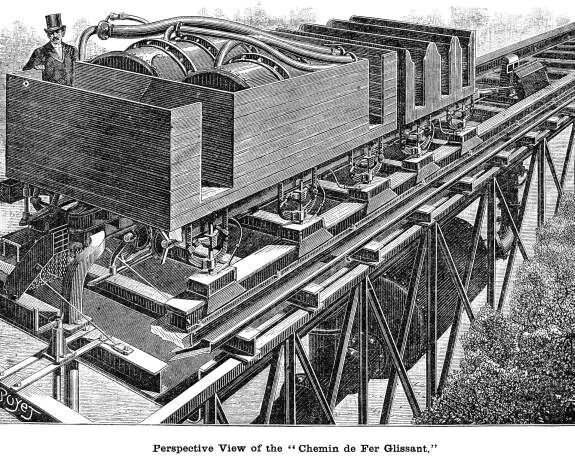|
The "Chemin de Per Glissant,"
or Gliding Railway.
Engineering News—October 26, 1889
 In our issue
of Aug. 31, a Paris correspondent gave to our readers sketches
and an excellent general account of this novel and promising method
of propulsion on railways now in operation in Paris. We supplement
this article by some further detail from Le Génie Civil
of Sept. 28, and reproduce from that journal a perspective
view which will better illustrate the general appearance of this
new hydraulic motor than anything we have given before. In our issue
of Aug. 31, a Paris correspondent gave to our readers sketches
and an excellent general account of this novel and promising method
of propulsion on railways now in operation in Paris. We supplement
this article by some further detail from Le Génie Civil
of Sept. 28, and reproduce from that journal a perspective
view which will better illustrate the general appearance of this
new hydraulic motor than anything we have given before.
The description of the operation already given was so complete
that we will only supplement it by giving some further collateral
data.
Among the first objections that are naturally made against
the method of M. GIRARD is the effect of
cold upon a system which rests entirely upon the use of water.
M. BARRE, the engineer, answers this objection
as follows: As all the liquid used in the various parts of the
machine is carefully gathered again for re-use, it is believed
that a regular service can be maintained in the climate of France
by a mixture of water with one-fifth part of glycerine. Even admitting
that the total loss would reach 1 per cent., the loss of glycerine
would only be 0.2 per cent. In place of glycerine the chloride
of magnesium may be used; the latter is cheaper than glycerine
and does not attack metal. A proportion of 1 of chloride to 7
of water would be sufficient.
If it is preferred to use the water alone, it would be necessary
then to protect, by non-conducting covering, the accumulators
and propulseurs, or motor jets. In the case of an elevated
metallic roadway these parts could be covered by wooden casing
placed between the girders. The reservoirs for the pumps could
be arranged in such a manner as to be heated in winter. With a
temperature of 5 degrees Fahr., for example, it would only be
necessary to raise the water to 61degrees Fahr. to permit the
whole apparatus to lie idle for 20 hours before the temperature
would fall to 32 degrees. The thin sheet of ice which would form
on the sides of the "rail," as it may be called, would
be melted, and removed by the water of the following train. The
only precaution necessary would be to detach the patins, or
slides, from contact with the rail after a long stop by circulating
through them for a few seconds a jet of steam before moving, from
the heating apparatus of the cars or otherwise In the case of
a line located upon the ground, the apparatus of propulsion would
be enclosed in a gallery placed either under the road or at the
sides.
As the movement of trains thus propelled is extremely easy
and produces no shock, it is alleged that the roadway may be placed
directly on the ground without any kind of ballast. [We doubt
this.-ED.] This feature, coupled with the ability to ascend steep
grades and pass around curves of short radius, enables the engineer
to practically follow the natural surface and to make the actual
construction very economical. The speed of these trains is very
considerable. There is no economical purpose in reducing it for
certain classes of traffic. In the case of curves, the friction
is no greater than on a straight line, for the trains reach the
curves always with the same velocity, and the rails can be so
inclined as to entirely destroy the centrifugal force,—a
result which cannot be reached in a combination of rails and wheels.
The important claim is justly made that in the cases of water
power of great volume and force found so often in mountain regions,
the expense of traction will be little more than that of selecting
and leading this power to the machine.
The advantages of the system are summed up by M. BARRE
as follows: (1) Ease of motion; no shaking and no lateral movement.
(2) No noise, dust, or smoke. (3) Derailment impossible, as no
foreign body can get under the shoes. (4) An almost instantaneous
stop without shock; as a consequence collisions may be easily
avoided. (5) Ease in ascending steep grades and passing around
curves of short radii. (6) A velocity touching 124 miles per hour,
with a pressure of 22 kilos. (313 lbs. per sq. in.) in the supplying
conduit. (7) Lightness of material in roadway, and consequently
economy in construction. (8) Considerable economy in the expense
of traction and in the weight and cost of carriages. (9) Notable
economy in repairs in the motive power. M. BARRE
estimates this latter item as being equal to 66 per cent., on
account of the reduction in the number of horse power necessary
to operate this machine, and because proper pumps for compressing
water move slowly and are not subject to the excessive shaking
and speed of moving parts incident to a locomotive in operation.
M. BARRE claims that the obstacles to
the system are included in the expense of the first plant, the
providing of considerable quantities of water, the action of cold,
etc.; not counting the obstacles as yet unforeseen which may arise
in practice. He claims that it is as easy to provide for the proper
supply of water to each shoe in use as it is to be assured of
the proper behavior of each wheel under an ordinary railway train.
Oddities
| Contents Page
|







